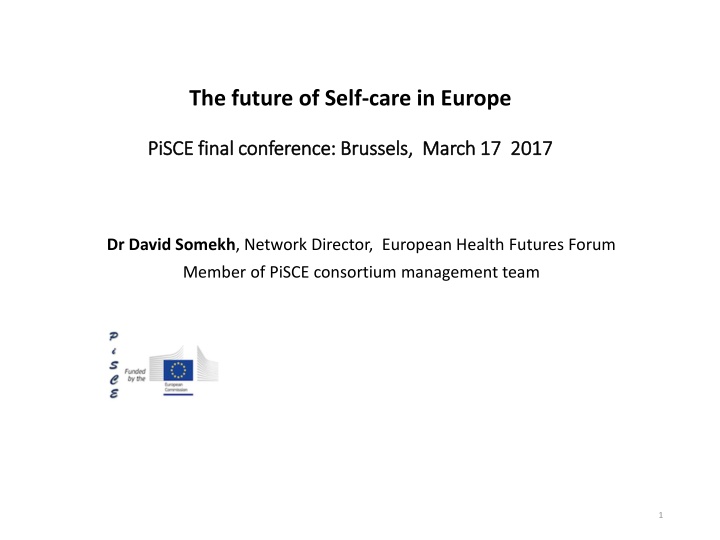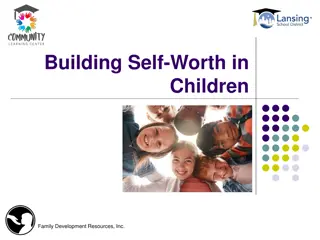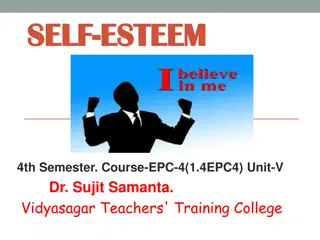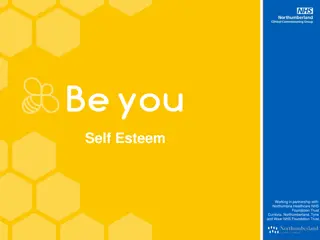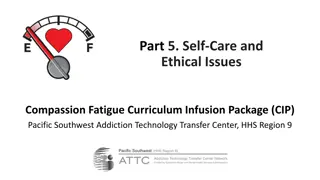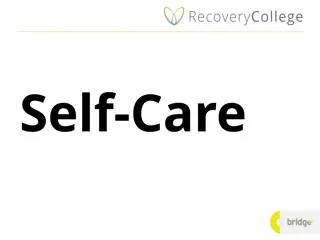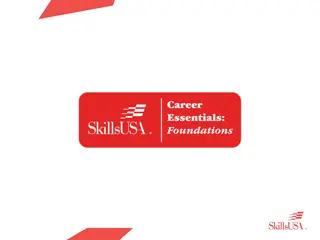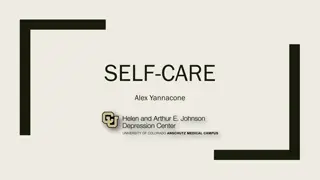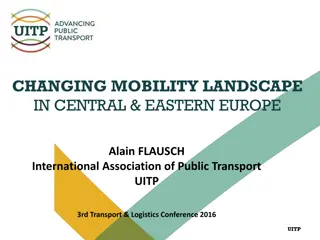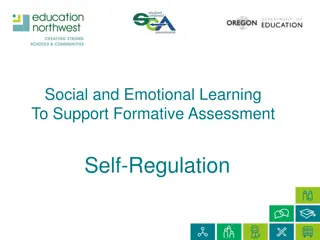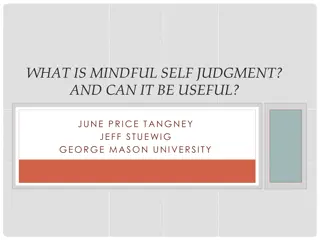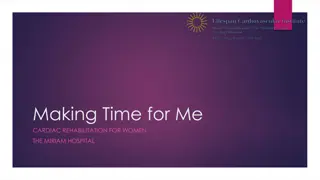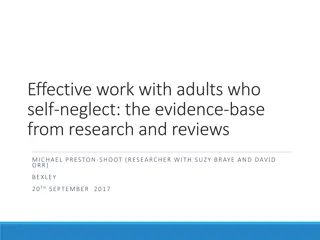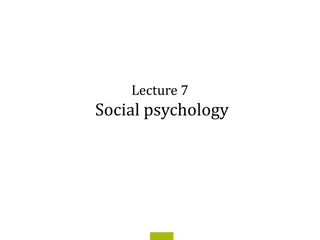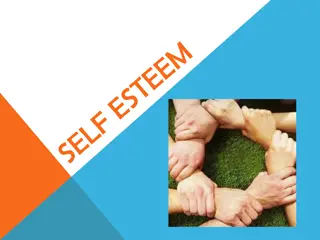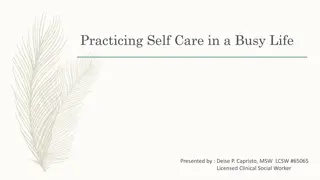The Future of Self-care in Europe - PiSCE Final Conference
The PiSCE final conference in Brussels focused on policy cohesion, the challenges in promoting self-care systems in Europe, and ongoing projects related to self-management and chronic diseases. Dr. David Somekh emphasized the need for evidence-based policy and potential disruptive changes to improve health outcomes.
Download Presentation

Please find below an Image/Link to download the presentation.
The content on the website is provided AS IS for your information and personal use only. It may not be sold, licensed, or shared on other websites without obtaining consent from the author.If you encounter any issues during the download, it is possible that the publisher has removed the file from their server.
You are allowed to download the files provided on this website for personal or commercial use, subject to the condition that they are used lawfully. All files are the property of their respective owners.
The content on the website is provided AS IS for your information and personal use only. It may not be sold, licensed, or shared on other websites without obtaining consent from the author.
E N D
Presentation Transcript
The future of Self-care in Europe PiSCE final conference: Brussels, March 17 2017 PiSCE final conference: Brussels, March 17 2017 Dr David Somekh, Network Director, European Health Futures Forum Member of PiSCE consortium management team 1
Acknowledgements The Commission, for their patience and support during the difficult transition period following the loss of the original Consortium lead partner The members of the Expert Platform for their willingness to work together and attempt to reconcile differences The mechanism within the European Parliament which allowed money additional to that for the Health Programme to be granted for pilot project(s) on promotion of self-care systems in Europe 2
Brief outline of the content of this presentation Policy cohesion is a significant issue Sensible policy is compromised by inadequate data Self-care is on the end of a continuum where responsibilities overlap, creating ambiguities The need to divert resources from illness- care to prevention and health promotion is well established, but the barriers to change appear very daunting There are two positive directions; to persevere with evidence based policy, but recognise that change will be slow, and to expect disruptive change, which may have unexpected consequences 3
The context of this project and ongoing work (1) 1. Three tenders related to self-management a) Empathie (empowering patients in the management of chronic diseases) (call: April 2013) b) PiSCE (Pilot project on the promotion of self-care systems in the European Union) (call: December 2013) c) PROSTEP (Promotion of self-care in chronic diseases) (call: July 2015) 4
The context of this project and ongoing work (2) 2. Related projects a) EU Joint Action on Chronic diseases (three year programme ending March 2017) b) a whole series of other projects that have overlap with themes in group 1 PALANTE (patient empowerment via eHealth)(CIP funding ICT policy support programme: finished June 2015) Health literacy e.g. HLS-EU (Chafea 2009-12), IROHLA (7th framework, finished Nov.2015) Several recent or current H2020 projects on supporting self- management of health and disease by ICT etc. etc. 5
was located in different units within the Commission. This presents a familiar dilemma, which is how valuable outputs from related studies can be integrated and inform the direction of future policy. How do the results of all these projects build a policy direction? Problem: the responsibility for the separate projects described A relevant example is health literacy, which resonates through the three linked projects. Health literacy is a key feature of one of the three pillars of patient empowerment, and in both PiSCE and PROSTEP it emerges as a significant enabling factor for self-care. Despite the public acknowledgement that self-care is an important feature of sustainable health systems, no unit within SANTE seems to be a champion of health literacy, as a policy direction 6
In his recent address to the Final meeting of the Chrodis JA Commissioner Andriukaitis offered one possible solution, but as we will see later, this brings its own difficulties with it. Before considering solutions, let s consider some other major barriers to progress in this area. 7
The availability of data: the related Cost Benefit Analysis (1) The commissioned tender for a CBA which preceded the PiSCE study aimed to provide a cost/benefit analysis of patient self-care oriented health systems in the European Union and the current frameworks in place to enhance self-care oriented heath care systems and patients empowerment . The actual CBA focused on analysis of the cost-benefit associated with eight self- care initiatives from five MS. Unfortunately, only the 4 UK initiatives met the study s best-practice criteria (NHS Direct, NHS 111, the MAS and the NMP). 8
The availability of data: the related Cost Benefit Analysis (2) While some benefit was found for all four, in their conclusions the writers acknowledge that a number of major assumptions were made to allow meaningful conclusions and that they lacked data, especially on what medications for minor ailments were actually handed out by pharmacies. Overall they concluded despite the fact that all the initiatives assessed in the CBA were England-based, the availability of data was a critical issue . Equally the number of comparable evaluations of self-care was very limited. Inevitably they concluded that more research was needed. 9
In the subsequent project, PROSTEP, we have also found that in comparison to systematic reviews of the clinical effectiveness of approaches to self-management in chronic disease, of which there is a good supply, there were significantly fewer CBAs to demonstrate equivalent cost- effectiveness. Does this matter? Experience suggests that policy built on financial benefit beats policy based on science alone! 10
The positioning of self-care in non life-threatening conditions There is another layer of complexity, and that is the context in which self- care/self-management is embedded in the wider continuum of health and healthcare. As will be seen, the area we are concerned with is in the far left of the continuum and interestingly, raises far wider questions than might be expected. 11
Firstly there is the question of the balance between personal responsibility and the influence from the State. It is in the interface between wellness, health promotion and management of minor conditions that there is potentially the most ambiguity of roles and expectations in this respect (see the Dutch comment on the next slide). Given the resource implications of the impact of chronic diseases, much greater attention has been given to that end of the spectrum than to maintaining wellness. Nevertheless studies of the former provide lessons for the promotion of the latter. To illustrate this: The slide that follows is from a WHO Observatory presentation at the Chrodis JA final conference last month and comments on National priorities regarding different elements of the continuum. This is part of Ellen Nolte s argument that much needs to be done to enable coordination along the care continuum, and the slide has three MS examples to make the point. 12
It is not yet in our habits to consider that chronic disease is a public health problem [...] I think that in France the culture, the medical or health culture, is more concerned on acute care than on prevention. [ ] the health authority has organised a lot of information and prevention campaigns and they are communication campaigns, but communication is not prevention. (France) [T]he Netherlands is good at the diagnosis phase and good at complications treatment [and] the last few years is gaining more interest in disease management ... Risk minimisation or prevention, the discussion is starting, the discussion of who is in charge of risk minimisation, the people themselves or local government or the health insurer.... (The Netherlands) which is also reflected in resource allocation: In Austria the area of risk minimisation is still considered as less important - perhaps not in theory but certainly when it comes to finding financial means for those programmes. Approaches concerning disease management are starting to get some attention at the moment. Provisions for acute care are very good. (Austria) Source: Knai et al.(2014) 13
Nolte cites also survey evidence across health systems of suboptimal engagement of service users in their own treatment and the corollary, as illustrated here, of lack of proactive engagement of service users (on the part of professionals) in wider health related behaviours i.e. the end of the continuum that is our focus 100 80 % respondents 60 40 20 0 AUS CAN FR GER NET NZ NOR SWE SWIZ UK US Did not talk about healthy diet, exercise, physical activity Did not talk about things in life that cause worry or stress Source: Osborn et al.(2016) 14
This is not meant as a discourtesy to Noltes careful analysis, but a comment on the problem of being so high-level in one s approach that one can t influence things on the ground, so to speak. It s a dilemma; the drawback of the helicopter view . Commissioner Andriukaitis in the address referred to earlier, said: To foster healthy ageing we need to start at the very beginning: birth, or even before! It is not just a question of addressing chronic diseases . I call on Member States and stakeholders to focus more on health promotion pro-active health promotion in all ages to keep people in good health, and for longer .This calls for pro-active and wide ranging national or regional policies with a greater focus on prevention, prophylaxis and patient monitoring. Addressing behavioural, social and environmental determinants, all together, is key (and he made specific reference to social inequality). 15
This absolutely logical call to arms links our current focus with the work on chronic diseases, as citizens ability to self-care for minor conditions is a facet of the health literacy which assists them (if they have it sufficiently) to maintain well-being and to be more effective in self- management when they develop chronic conditions (which they inevitably will, if they live a normal lifespan). Commissioner Andriukaitis also offered a partial solution to the policy cohesion issue raised earlier; the setting up of a High Level Steering Group on Promotion and Prevention. It would have a helicopter view on all recommendations coming from various projects and working groups on prevention, promotion and management of chronic disease Collect evidence of successful implementation of any of these recommendations in Member States and then encourage implementation in other MS Assess whether the new recommendations are useful or not and indicate where there are gaps 16
This interesting development should become a source of information and potentially valuable evidence on which to base policy going forward, but with no stakeholder representation, runs the risk of lacking connection with what was happening at the coal-face . The other issue that the Commissioner's emphasis on the importance of prevention and health promotion raises is this is not new, is it? At the European Health Forum Gastein five years ago, Hans Kluge, Director, Division of Health Systems and Public Health, WHO Regional Office for Europe gave a presentation: what will our health systems look like in 2050? Among other necessary directions, taking into account the emerging contexts that we are all familiar with, he emphasised the need for sustainable prevention and promotion and investment in primary care and for mechanisms to Increase the balance on prevention approaches vs treatment as a more cost effective way of maximising health gain 17
The point of juxtaposing the two statements is that it underlines the fact that progress in this area is painfully slow. The negative influence of vested interest from all sides in maintaining the status quo in healthcare, the complexity of systems and the financial realities of the last decade are understandable and ever-present barriers to change. What is required it seems is a different way of seeing health within society, a holistic view, and this paradigm requires cooperation between players that just doesn't normally happen these days, at least not to any significant degree. A Public Health Agency Canada paper (http://www.phac-aspc.gc.ca/ph- sp/php-psp/index-eng.php ) on Public Health Promotion, their national programme, comments: our model illustrates how many of the levers for influencing health lie outside the health sector. Thus, organizations within the health sector will need to adopt a number of roles. While they will still be required to provide direct service in the form of financial resources, knowledge and technology, they will increasingly be required to assume an "influencing" role where their role will be to work with other sectors whose programs and policies have an impact on people's health. 18
This last point is echoed in a concluding remark by the Commissioner address: I encourage you to focus on implementation, paying close attention to multi-professional and multi-sectorial collaboration. How we achieve these goals is another matter. We can attempt to negotiate with businesses determined to promote the consumption of corn syrup and the like by any means, and the evidence is that small gains could be made this way, or we can take a leaf out of their book and use promotional methods that don t espouse a paternalistic perspective of what is good or bad for the citizen s health, but rather make healthy lifestyle attractive, desirable etc. This will take time and require allies, that is, co-workers, the most obvious being those in the education system. 19
To some extent the merchants of fitness Apps have had some success here, but its patchy. This is a bottom-up approach to wellness, arising without the sanction of policy. Easy to sell the idea to the fit, financially comfortable youth, but not so easy in more needy sectors. Equally, many health professionals have difficulty themselves with this new technology, especially when their patients ask for advice, because they don t feel sufficiently digitally literate (yet) to give a considered view. In conclusion: One option is that we persevere with the kind of evidence-based approach advocated in the PiSCE study, aware that progress will be slow and where innovation emerges, it will be utilised. But expectations have to be realistic The second point, in parallel, is that change will emerge whether we like it or not and in a way which allows us limited ability to control it. Health Apps have already been referred to. The establishment is preoccupied with accrediting them. While safety, like data security certainly matters, it can be over-valued and become a barrier to change in itself. Where digital mechanisms, like social media, operate independently of our health systems, even monitoring the public s use of them, like use of internet sources is a problem, but may become a significant factor. 20
The Walmart example: (http://www.fiercehealthcare.com/healthcare/himss-2017-hx360-retail- healthcare-innovation-walmart-american-well-aarp ). Providing free large-scale health monitoring as an extra incentive to get people into the store. Then trying to build an ecosystem with healthcare providers. Is this a real application of disruptive innovation? Doing something more simply, at less cost, making a good accessible to a much wider group. This is one of the things that we need in order to improve Public Health, but it will probably be provided by those that we don t normally work directly with: and they will come to us an alternative view of cross-sectoral cooperation! 21
